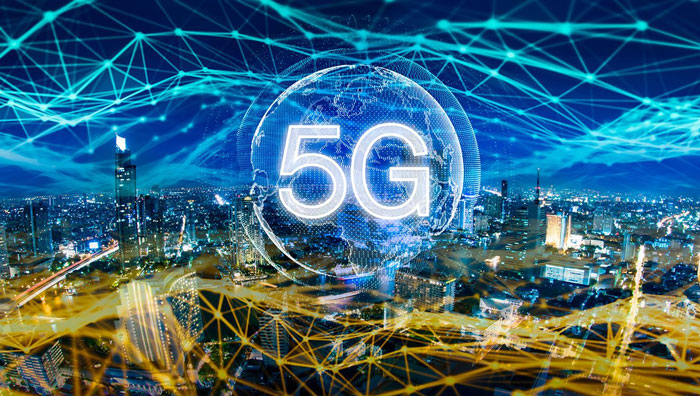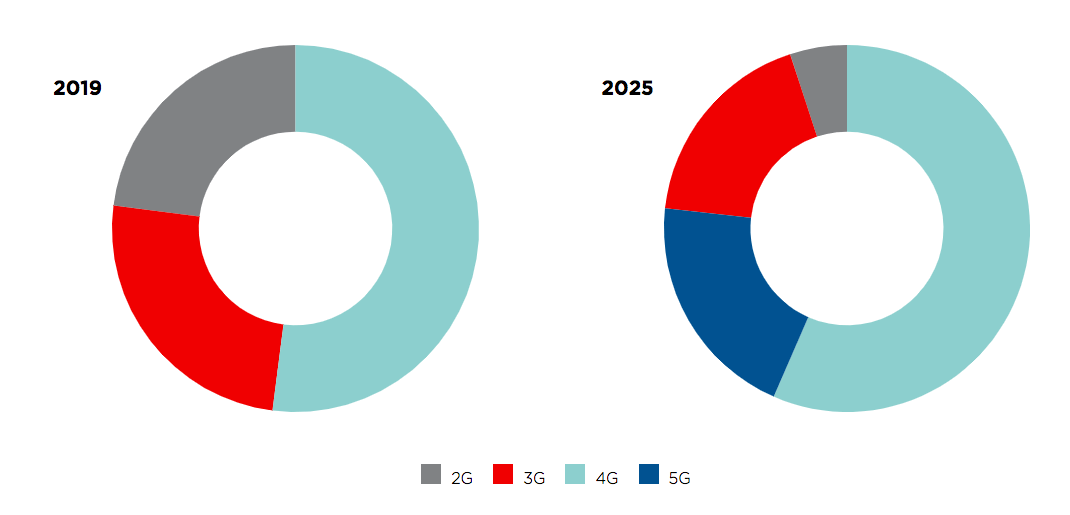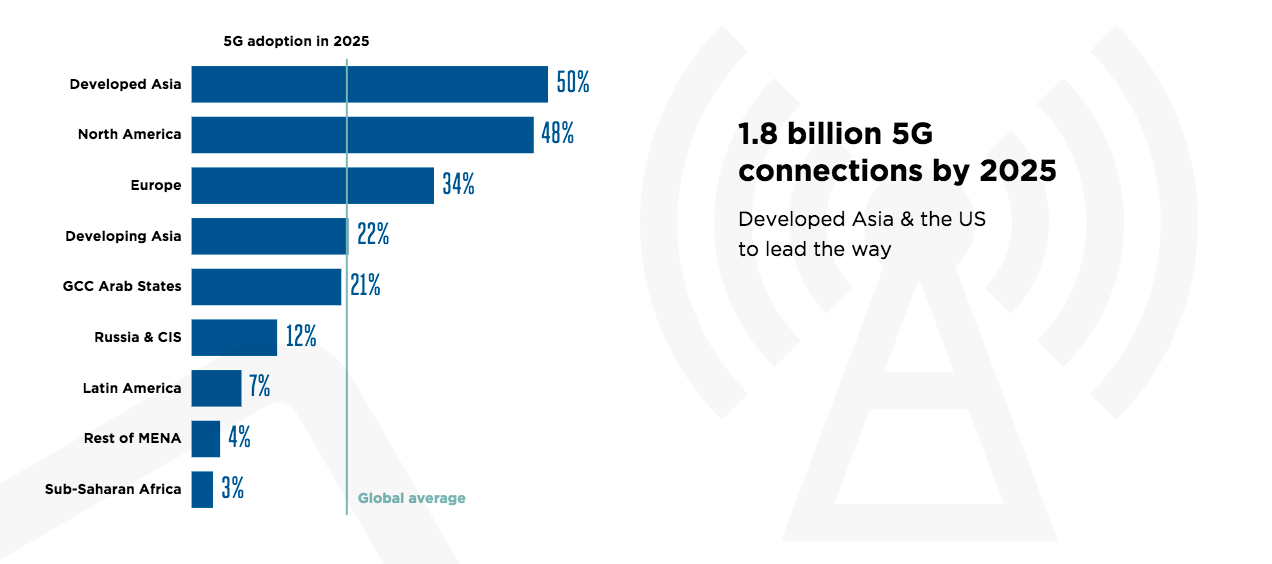
This year, one of the main topics in the tech world has been the spread of 5G mobile networks. According to someexperts, the widespread adoption of technology will changethe everyday world around will allow the Internet of Things (IoT) to reach a new level of development, and at the same time, it will help mass adaptation of cryptocurrencies through microtransactions in IoT devices.
Mining-Cryptocurrency.ru figured out what role blockchain and cryptocurrencies will play in the upcoming IoT revolution.
The introduction of 5G technology will allow machines to communicate with each other
5G - fifth generation mobile network,using millimeter waves of the radio spectrum. It is capable of transmitting data at a speed of 1 to 20 gigabits per second (100 times faster than 4G), with a low delay between receiving and transmitting a signal and the ability to connect to a huge number of devices. This is one of the most important technological breakthroughs of recent times, part of the fourth industrial revolution.
Widespread adoption of 5G is expectedwill change our daily life, a number of industries, as well as the functioning and development of business. 5G will do more than just improve communication between people. Much more importantly, it will take machine-to-machine (M2M) communications to a new level. 5G will allow machines to “talk” to each other almost instantly.
Futuristic projects such as “smart cities”that have been talked about for so many years are finally getting the technology that can make them a reality. Over the next decade, 5G could significantly transform entire sectors of the economy, even traditional ones such as agriculture, mining and healthcare.
Here are a few possible technical innovations that will become available with the massive introduction of 5G:
- Widespread use of IoT devices in production and at home, the emergence of "smart cities";
- A new round of production automation, even greater robotization, “smart factories”;
- Autonomous transport;
- Almost instant download of HD-video, new opportunities for the development of the gaming industry, augmented and virtual reality;
- Increasing the amount of remote customer service;
- The growth in the number of payments using various devices.
How soon will 5G networks become mass?
So that the changes described above canTo become a reality, 5G networks must become truly widespread. And according to GSMA's March Mobile Economy report, this will happen within the next five years, by 2025.
European Union, Americas andSoutheast Asia has been testing the technology for several years. So far, the leaders are South Korea, the USA, China, Australia, Japan, Switzerland, Austria, Italy and the United Kingdom - they have already launched existing networks offering commercial services.
5G mobile operators are testing 5G in RussiaMegafon and MTS. True, while the authorities do not open for use the 5G frequency at 3.4-3.8 GHz - the main range in the rest of the world - since it is occupied by power structures in our country. A delay with this threatens Russia with another lag behind Europe, the USA and China.
2020 should be a turning point in5G distribution - the network can be launched in a dozen countries and regions. According to GSMA, 5G is now available to 46 commercial operators in 24 markets around the world, and another 79 operators in 39 markets have announced plans to launch this service.
The share of generations of mobile networks in 2019 and their estimated ratio in 2025 according to GSMA forecasts:

The number of devices that can connect to 5G is also growing. According to GSMA forecasts, by 2025 there will be 1.8 billion devices connected to 5G in the world:
- 1.22 billion in China,
- 230 million in Europe,
- 200 million in the USA,
- 54 million in Russia and the CIS.
Estimated share of countries in the total number of IoT devices by 2025 according to GSMA forecasts:

5G will allow you to build an M2M economy
High speed is not the main advantage of 5G. To build a large-scale IoT infrastructure, the ultra-low delay between receiving and transmitting a signal is less important - less than one millisecond (for comparison, 4G - from 50 milliseconds).
In the coming years, we should expect a real boomIoT devices. So, according to GSMA forecasts, in the period from 2019 to 2025 the number of IoT devices will more than double, and the global revenue from this sector will triple - to $ 1.1 trillion.
As spreadIoT devices - from smartphones and home appliances to self-driving cars - they will be networked. Devices will be able to exchange data with each other, including microtransactions without human intervention.
This will create the prerequisites for the appearance ofM2M economics is a system in which smart devices act as full participants. For example, self-driving cars will independently pay for gas at an autonomous gas station, stores will automatically charge the buyer for goods, traffic lights will immediately write off the fine if traffic rules have been violated.
Blockchain will ensure the security of M2M transactions
One of the problems facedIoT infrastructure, there will be privacy and data security. Not all Internet-enabled devices comply with the same cybersecurity standards as smartphones and laptops. Moreover, this industry is only emerging - all possible vulnerabilities have not yet been identified. And the widespread use of IoT devices will increase the amount of data that the user shares. Without security tools for this data, large-scale IoT deployments can slow down significantly.
Now most of the IoT infrastructurecentralized, for example, Google Home, which controls the "smart home". This is a risk both for the consumer (for example, if he uses several devices), and for corporations. Malicious devices that connect to the IoT network can cause disruptions in it, and user data will be compromised or stolen.
Decentralized public blockchains are sustainableto unauthorized interference and can make the payment IoT infrastructure safe and secure. However, most blockchains have limited performance and are not suitable for mass use and microtransactions. Their use in the IoT infrastructure would lead to network congestion.
The way out of this may be in blockchain solutionssecond level. Thus, Bitfury employees suggest that the Lightning Network (LN) could be an excellent payment structure for transactions between IoT devices. This protocol is designed to interact with other blockchains through special payment channels, which will allow IoT devices to use different cryptocurrencies. Blockchains could provide consensus and security, and most transactions would take place on second-layer networks.
Another similar solution could be Plasma technology on the Ethereum network or a directed acyclic graph (DAG) used, for example, in Hedera Hashgraph and IOTA.
5G can expand the functionality and capabilities of cryptocurrencies
To assess the magnitude of the changes that maybring 5G, IoT and blockchain, they must be considered in aggregate, and not separately. These are interconnected technologies, each of which develops another. 5G is not enough for a full-fledged IoT infrastructure. The blockchain in this bundle is responsible for security and decentralization.
However, 5G will also positively affect the development of cryptocurrencies and decentralized blockchains.
- The growth of mobile cryptocurrencies.Low latency and high speed 5G will allowcrypto wallets and payment services, including mobile ones, become faster and more convenient to use. This could significantly increase the number of crypto transactions from smartphones, especially in developing countries, whose residents access the Internet primarily through phones.
- Empowering smart contracts.Smart contracts often depend on oracles −blockchain protocols that check the conditions for their execution and collect external data to execute a transaction in the chain. However, if the oracle makes a mistake, the smart contract will either fail or be executed incorrectly. 5G will allow IoT devices to collect data in real time, which will increase the reliability of the information transmitted by the oracle.
- Improving network bandwidth.The high speed and low latency of 5G canlead to a sharp increase in the number of additional nodes joining shared blockchains. The network can grow due to the operation of devices that are currently offline - the same smartphones and tablets. Reducing latency would also allow developers to experiment with reducing block generation time, which would also have a positive impact on the throughput and decentralization of the blockchain network.
Emerging Market Leadership
Despite the fact that the M2M economy is a matter of the near future, a number of crypto projects are already fighting for leadership in the emerging market.
The most striking example is, of course, IOTA.The project team has been promoting its protocol for several years, designed for IoT devices and striving to become the basis of the emerging M2M economy. Other cryptocurrencies focused on M2M transactions include Atonomi (ATMI), Power Ledger (POWR), Waltonchain (WTC), Vechain (VET), IoTeX (IOTX), IoT Chain (ITC), Ambrosus (AMB) among others .
Moreover, the fight for this market has already enteredmobile operators. In April 2019, the largest Korean telecom company KT Corporation launched a blockchain service for 5G networks, GiGA Chain. It allows you to hide the IP addresses of IoT devices. They are accessed through the GiGA Stealth service, which issues one-time key tokens to the service using smart contracts.
Tech giants fight for future standardsnew IoT networks. Last year, Huawei had more than 1,000 patents on 5G technology—37% of the total. And Samsung has already begun developing a new mobile communication standard - 6G.
There are already several dozen startups on the market working on combining IoT and blockchain:
- The Helium project has been working since 2013 to launch a network to transfer data between IoT devices. Last year, the company added tokens and blockchain to its business model.
- The Chronicled team is developing blockchain-based software for the logistics of food and medicine.
- ArcTouch startup launches voice assistants, wearables, and smart TVs.
- And the Filament project is for IoT devices in the construction, manufacturing, energy and transport industries.
- HYPR is working on launching software to protect ATMs, cars, locks and houses connected to IoT networks.
- Xage team releases IoT solutions for agriculture, energy, transport and utilities.
The internet of things will eventually allowautomate even more areas of life and production and create an M2M economy. It is likely that cryptocurrencies will become part of the IoT revolution, taking the place of digital money in it for microtransactions between devices. Now there are few crypto projects focused on the IoT industry, but in the near future their number will increase sharply due to the spread of 5G networks.
</p>Rate this publication



